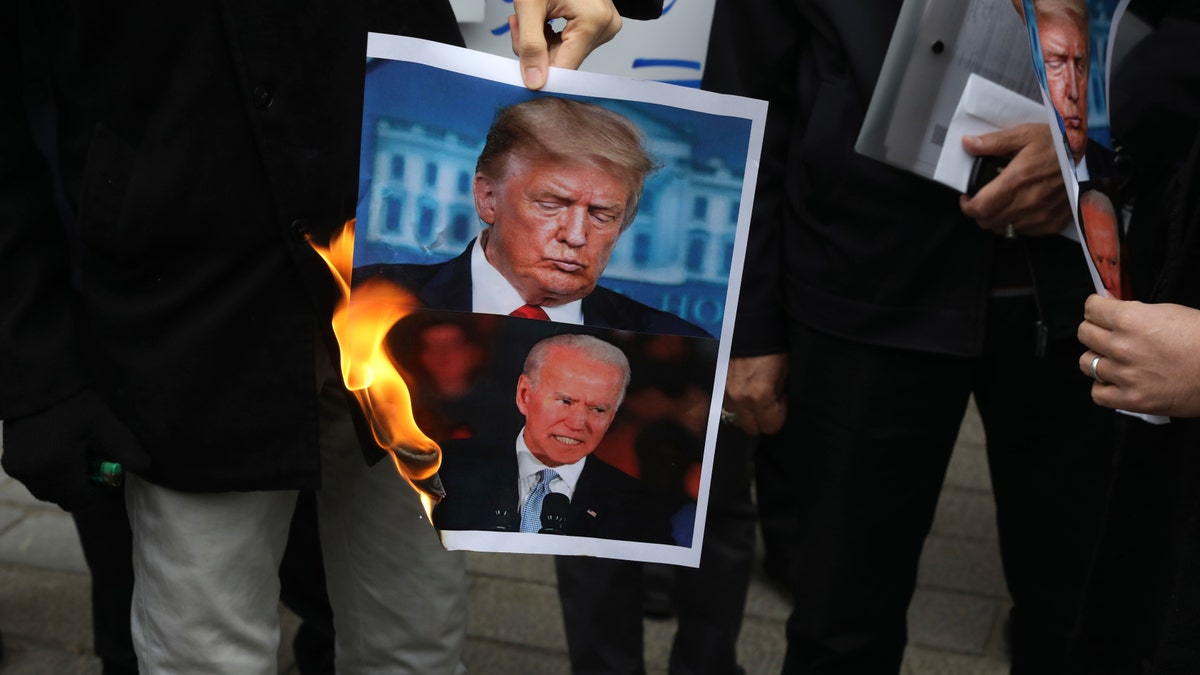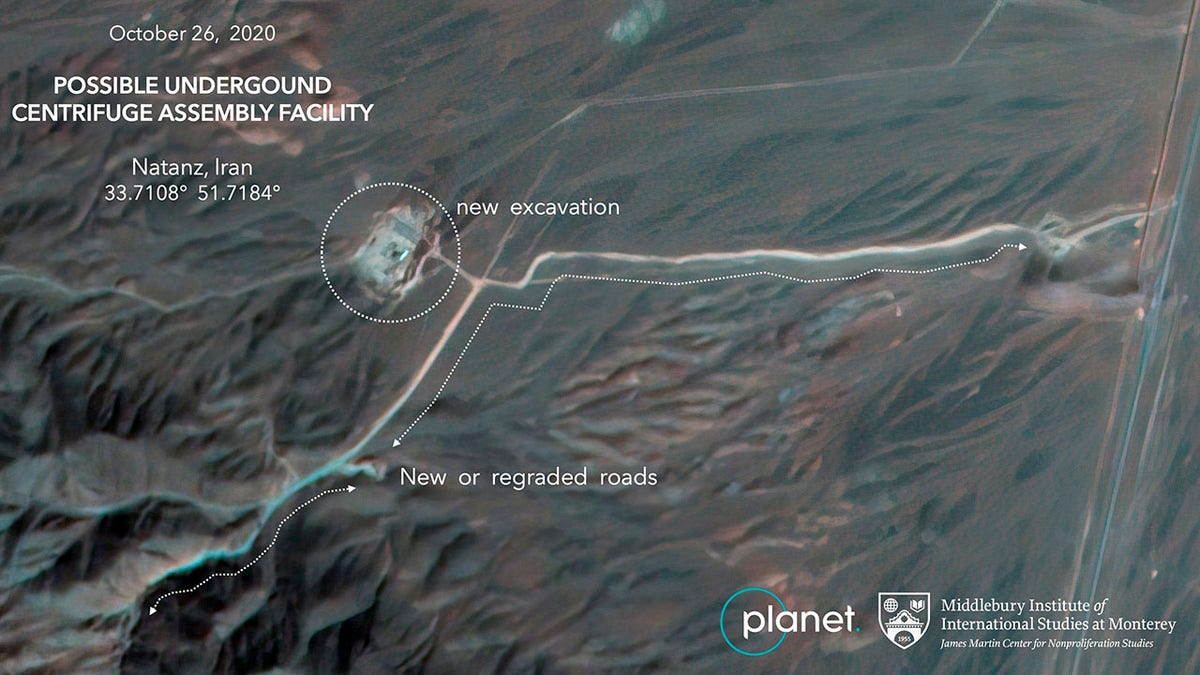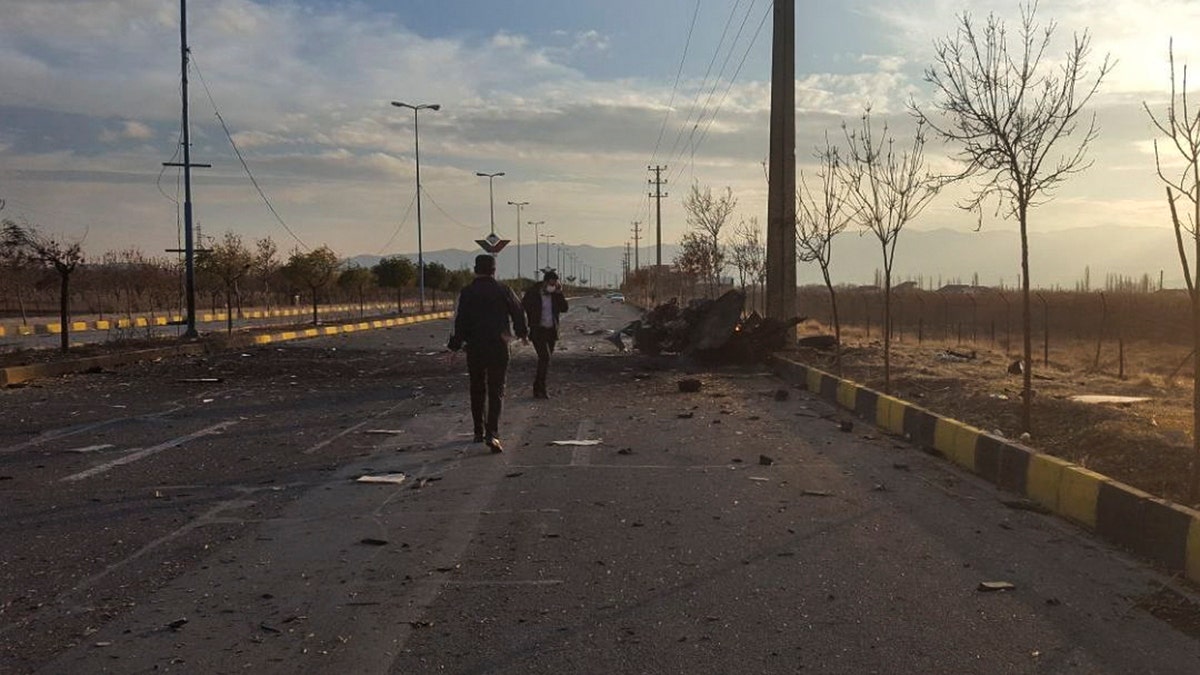Cotton: 'Dangerous' for Joe Biden to rejoin Iran nuclear deal
GOP senator joins 'The Story' to discuss the 'reorganization' in the Middle East under President Trump
As the dust settles following the assassination of Iranian nuclear scientist Mohsen Fakhrizadeh last Friday, the international community is once again forced to confront the troubling question of where does Iran currently stand when it comes to nuclear ambitions.
After its program was officially shuttered due to international pressure in 2003, Tehran has repeatedly denied that its atomic aspirations have been covertly revived. The country's entrance into the 2015 Joint Comprehensive Plan of Action (JCPOA) – the controversial so-called Iran nuclear deal – was centered on the premise it would continue halting its program for another 15 years.
According to the most recent Institute for Science and International Security (ISIS) analysis of the International Atomic Energy Agency (IAEA) Iran Verification and Monitoring Report, released in November, Iran's low enriched uranium (LEU) stock now exceeds by 12-fold the limit set in the JCPOA.
"As of November 2, 2020, Iran had a stockpile of about 3613.8 kilograms (kg) of LEU (hexafluoride mass), all enriched below 5 percent, or the equivalent of 2442.9 kg (uranium mass)," the review stated, highlighting that over the period August-November, "Iran's estimated breakout time as of early November 2020 is as short as 3.5 months."
WHAT HE KNEW: WHY IRANIAN NUCLEAR SCIENTIST MOHSEN FAKHRIZADEH WAS MARKED FOR DEATH
The theoretical "breakout" time is an estimate of how long one would need to procure enough weapons-grade uranium to produce a bomb.
"Iran now has sufficient low enriched uranium to produce enough weapons-grade uranium for a second nuclear weapon, where the second one could be produced more quickly than the first," the ISIS analysis authored by David Albright, Sarah Burkhard, and Andrea Stricker continued. "Iran would require, in total, as little as 5.5 to 6 months to produce enough weapons-grade uranium for two nuclear weapons."

In this picture released by the official website of the office of the Iranian supreme leader, Mohsen Fakhrizadeh sits in a meeting with Supreme Leader Ayatollah Ali Khamenei in Tehran, Iran, Jan. 23, 2019. Fakhrizadeh, an Iranian scientist that Israel alleged led the Islamic Republic's military nuclear program until its disbanding in the early 2000s was killed in a targeted attack that saw gunmen use explosives and machine gun fire Friday Nov. 27, 2020, state television said. Two others are unidentified. (Office of the Iranian Supreme Leader via AP)
It would likely require a year or more to weaponize that fissile material for a nuclear device, Stricker – also a research fellow for the Foundation for Defense of Democracies (FDD) – told Fox News this week.
The assessment further emphasized that Iran is starting the process of installing advanced centrifuges – machines needed for enrichment – in the Natanz Fuel Enrichment Plant (FEP) in violation of the JCPOA.
Moreover, the IAEA's JCPOA verification report itself stringently condemns Iran for "not addressing a critical issue involving undeclared nuclear material and activities, concluding that Iran's explanations are 'unsatisfactory' and 'not technically credible.'"
The Trump administration unilaterally pulled out of the agreement in 2018 – subsequently slapping on hefty economic sanctions on Iran. For its part, Tehran has subsequently wavered on how much they would actively encroach the terms of the deal – of which China, France, Russia, the United Kingdom and Germany in conjunction with the European Union are still part – in response to the U.S.'s "maximum pressure" campaign.
IAEA's probe also found "undeclared materials and activities at two sites in Iran" – the Tehran pilot uranium conversion plant and the Marivan site, which were part of Iran's nuclear weapons program in the early 2000s.
"Unexpectedly, the IAEA did not report on this issue either in this report or a separate safeguards report," the ISIS assessment underscores, adding that, under a related investigation into Iran's compliance with its safeguards obligations, "the IAEA is investigating Iran's previous undeclared military uranium conversion activities."

A group of protesters burn pictures of the U.S. President Donald Trump, top, and the President-elect Joe Biden in a gathering in front of Iranian Foreign Ministry on Saturday, Nov. 28, 2020, a day after the killing of Mohsen Fakhrizadeh an Iranian scientist linked to the country's nuclear program by unknown assailants near Tehran. (AP Photo/Vahid Salemi)
While the IAEA is said to have taken samples at the two unlisted sites in question after "months of delay" in being granted access, the U.N. reporting body is yet to document its discoveries and whether or not they contained undeclared nuclear materials.
Michael Makovsky, the president and CEO of the Jewish Institute for National Security of America (JINSA), concurred that the number of bombs Iran could ultimately produce is certainly growing, while the time needed to actually make one bomb's worth of fissile material is shrinking to a "dangerously small window," much of the concern is that it is down to a guessing game.
"We don't actually know precisely how long Iran would need to turn this into a testable nuclear weapon – one of the JCPOA's key flaws was allowing Iran to keep inspectors in the dark about the true extent of covert bomb design under Fakhrizadeh," he said.
WORLD'S NUCLEAR CAPABILITIES ARE DECREASING IN OVERALL NUMBERS BUT GROWING DEADLIER
Another study released last month by the Institute for Science and International Security, titled "The Amad Plan Pilot Uranium Conversion Site, Which Iran Denies Ever Existed," further highlights the cracks of distrust between what Iranian officials were stating and what was really going on under the veil of obscurity.
The report came following the not-yet-determined summer visit by the IAEA to an Iranian site, termed the "Tehran Site," spurred by concern "that the site had possessed undeclared nuclear material, in particular uranium, a violation of Iran's safeguards agreement."
"The site was involved in pilot-scale uranium conversion under the Amad Plan in the early 2000s and was dismantled in 2004," the institute's summary noted.
The Amad Plan was the name given to Iran's atomic-centered program pre-2003.
The June 2020 IAEA report stressed that a "possible location" for "use or storage of nuclear material and/or conducting nuclear-related activities, including research and development activities related to the nuclear fuel cycle" may have been used for the "processing and conversion of uranium ore, including fluorination in 2003."
Fluorination of uranium generally means the production of uranium hexafluoride, a vital gas required for the function of gas centrifuges, and the IAEA also documented that the location in question also endured "significant changes in 2004, including the demolition of most buildings."
While inspectors took environmental samples in a bid to determine any resumed activity, such findings are not yet known.

This Monday, Oct. 26, 2020, satellite image from Planet Labs Inc. that has been annotated by experts at the James Martin Center for Nonproliferation Studies at Middlebury Institute of International Studies shows construction at Iran's Natanz uranium-enrichment facility that experts believe may be a new, underground centrifuge assembly plant. Satellite photos show Iran has begun construction at its Natanz nuclear facility. (Planet Labs Inc. via AP)
Nonetheless, steady acceleration and accumulation have been ongoing over the past year.
In March, inspection reports signaled that Iran's burgeoning arsenal of nuclear fuel had reached new heights, concluding that Tehran appeared to have stockpiled enough enriched uranium to produce at least one nuclear weapon. However, experts deduced that it takes months or potentially years to manufacture a warhead and propel it over significant distances – requiring immense technical skill and capability – something that Fakhrizadeh was alleged to have been working on ahead of his assassination.
A status report drawn up by the Congressional Research Service last December indicates that, even though efforts to amass materials were well underway as of 2003, the technical mastery to bring a bomb to fruition was still lacking.
John Wood, a defense and security expert and analyst, also highlighted that Fakhrizadeh was the head of FEDAT, which is comprised of approximately 600 people divided into 12 departments and provides the leadership for the nuclear weaponization program.
"It works closely with Shahid Beheshti University on constructing the nuclear trigger," he said. "Although the personnel of FEDAT will miss Fakhrizadeh, their mission will go ahead with more urgency than ever."
In addition to deepening mistrust and ratcheting up tensions between Tehran and Washington, the findings also ignited queries as to whether the IAEA, which reports to the U.N. Security Council, although considered an independent agency, needed to demand more invasive inspections.
Last November, the IAEA reported that Iran had amassed roughly 1,200 pounds of uranium hexafluoride that was "moderately enriched" to less than 4.5% 235U.
"If further enriched, this quantity could yield more than 30 kilograms (66 pounds) of weapons-grade uranium, enough to build one fission bomb," an analysis published earlier this year by the Scientific American conjectured.
Weapons-grade uranium can be converted from low-enriched uranium – which is utilized in nuclear power plants – with supplemental refining.
The apparent replenishment of the depository over much of the past year comes less than four years after Iran pledged to have transferred out some 97% of its uranium fuel in adherence to the JCPOA.
Moreover, with much of the world distracted and burdened by the coronavirus pandemic, additional anxieties were being raised pertaining to possible new construction plans for a centrifuge assembly plant.
"This summer, Iran decided to construct a new underground centrifuge assembly plant, following the destruction of the above-ground one at the Natanz enrichment site on July 2, 2020," observed an October ISIS report. "A nearby gunnery range appears to have been converted to a construction support and staging area in the first half of September. Because of the added difficulties of building an underground site, the completion of a new centrifuge assembly plant able to assemble thousands of advanced centrifuges per year is unlikely in 2021."
The institute cautioned that construction of the leading centrifuge assembly center "could start soon."
"The tunnel area and its surroundings should continue to be monitored closely. Bringing a new centrifuge assembly center into operation may take several years if the goal is to assemble thousands of advanced centrifuges per year," it concluded. "Whatever Iran pursues, including the construction of more than one facility or an underground one, these sites will remain vulnerable to attack. Rendering inoperable a centrifuge assembly facility, dependent on a cleanroom environment, does not require the destruction of the tunnel itself."
BIDEN WILL TRY TO REVITALIZE 'SMOKE AND MIRRORS' IRAN DEAL: KT MCFARLAND
But whether the Islamic Republic will continue down such a path or will instead seek talks with the incoming Biden White House to have sanctions lifted and frozen money returned in exchange for promises to again suspend its stockpiling remains to be seen.
"The U.S. departure from the nuclear deal under President Trump was a painful but needed course correction. In the short term, Iran has increased its uranium production but faces substantial economic pain that the next administration could draw on to reach a stronger deal," Stricker said. "Washington should not rejoin the nuclear deal but seek a stronger and more lasting agreement that forecloses Iran's fissile material pathways to a bomb and requires it to fully disclose and end its ongoing nuclear weapons activities."
Royce de Melo, a Middle East security and defense consultant, also italicized that the Obama-era nuclear deal "had too many loopholes and restrictions in Iran's favor, which would have had the Iranians easily hiding what they would want to hide."
"Besides that, the deal was basically for a 10 to the 15-year period, very temporary; to have a deal that is longer-lasting makes more sense," he asserted.

This photo released by the semi-official Fars News Agency shows the scene where Mohsen Fakhrizadeh was killed in Absard, a small city just east of the capital, Tehran, Iran, Friday, Nov. 27, 2020. Fakhrizadeh, an Iranian scientist that Israel alleged led the Islamic Republic's military nuclear program until its disbanding in the early 2000s was “assassinated” Friday, state television said. (Fars News Agency via AP)
However, others argue that the JCPOA kept Americans safer than the Trump team's pressure campaign.
"The JCPOA was blocking all their pathways to a nuclear weapons capability, but one year after President Trump withdrew from the nuclear deal, Iran began incrementally breaching its limits in order to increase its political leverage for future talks," said Samuel Hickey, research analyst at the Center for Arms Control and Non-Proliferation. "Iranians are closer to a nuclear weapon today than they were on the day President Trump was sworn into office."
CLICK HERE TO GET THE FOX NEWS APP
Nonetheless, experts also warn that while the slaying of Fakhrizadeh, the alleged brains behind the embattled nation's previous atomic attempts, are likely to stagnate – not squash – any future hopes of building a nuclear weapon.
"If, as is the official narrative, the weapon's program (the Ahmad plan) was mothballed in 2003, then why did this attack occur at all? The answer is obvious," Wood added.





















